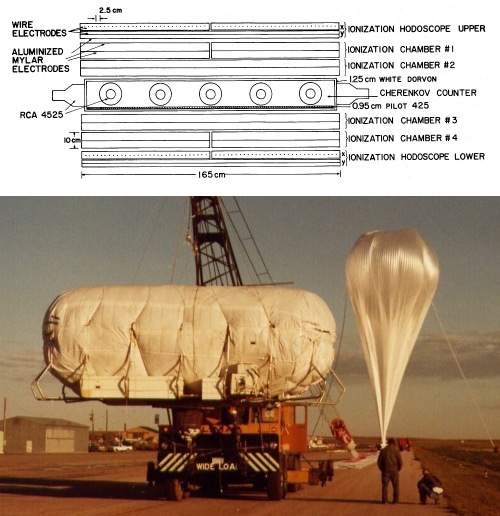Purpose of the flight and payload description
The objective of the flight was to measure the relative abundances of Fe, Co, Ni, Cu, and Zn in the cosmic rays using a large-area balloon-borne electronic detector system. The system was developed by the McDonnell Center for the Space Sciences and Department of Physics at the Washington University in St. Louis.
The detector was composed of two nearly identical systems, side-by-side inside a single aluminum pressure vessel. A cross section of one system is shown in the figure at left and below a picture of the fully assembled system ready to flight. The detector had a large geometrical factor and was very thin to allow for the collection of a large number of cosmic rays with a small probability of nuclear interaction on it. The charge and velocity of each incident nucleus were determined by the dE/dx-C method wherein dE/dx, the rate of energy loss of the nucleus, was measured by the ionization in the ion chamber gas; and C was the intensity of Cerenkov radiation produced by the nucleus in passing through a Lucite radiator.
The measurement of the rate of energy loss, dE/dX, was made by dual gap, pulse ionization chambers. Four independent ionization measurements were made, two above, and two below the Cherenkov counter. The ionization signal, I, was derived by taking the mean of these four measurements. The light output from the 0.64 cm thick Pilot 425 radiator in the Cherenkov counter was measured by two independent sets of photomultiplier tubes. The Cherenkov signal, C, was derived by taking the mean of the signals from these two sets of tubes. The ionization hodoscopes provided the trajectory information necessary to calculate the path-length in each detector and to correct for areal non-uniformities in the ionization and Cherenkov responses.
The cosmic-ray trajectory defined by the hodoscopes also gave the zenith angle of the incoming particles, which was necessary for calculating the actual atmospheric depth traversed by each nucleus. The signals I and C were both proportional to the square of the charge but proportional to different functions of the velocity of the cosmic ray. This allowed to derive a unique charge and energy determination for every element above magnesium (Z=12) in the energy range from 330 to 1200 MeV measured at the middle of the Cherenkov radiator. For iron, the energy interval for essentially unambiguous element identi?cation could be extended to approximately 20 GeV because of the negligible abundance of cobalt (Z=27). To record the events for each of the two detector blocks was used an incremental magnetic tape recorder, which was capable of recording up to five events per second.
The vessel was covered with a special insulation canvas and mounted in a support structure of aluminum tubing that provided a platform for external power supplies, balloon instrumentation, and supplemental landing shock absorbers. The structure was designed to absorb landing forces without affecting the vessel. Ballast was contained in a centrally located canvas hopper under the experiment.
Details of the balloon flight
Balloon launched on: 9/13/1977 at 13:39 utc
Launch site: Pierre Municipal Airport, South Dakota, US
Balloon launched by: National Scientific Balloon Facility (NSBF)
Balloon manufacturer/size/composition: Zero Pressure Balloon Winzen 1.121.350 m3 (20 microns)
Flight identification number: 140N
End of flight (L for landing time, W for last contact, otherwise termination time): 9/14/1977
Balloon flight duration (F: time at float only, otherwise total flight time in d:days / h:hours or m:minutes - ): F 40 h
Landing site: 35 miles E of Minot, North Dakota, US
Payload weight: 2868 kgs
The balloon was launched from Pierre, South Dakota on the morning of September 13, 1977 at 08:38 CDT. This location was chosen because of its low geomagnetic cutoff.
The balloon system ascended at an average rate of 2.21 meters per second to a float altitude of 3.75 Mbs. Failure of the ballast release mechanism during the flight was responsible for severe variations in altitude. At sunset the balloon started a slow descent to approximately 20 g/cm2 and then rose back to float altitude when the morning sun heated the balloon. After a flight of 44.5 hours the mission was terminated from the tracking aircraft. The gondola landed safely 35 NM east of Minot, North Dakota at 5:20 CDT on September 14, 1977.
An advantage of the unusual altitude profile for the scientific experiment was that it provided significant measurement time over a wide range of atmospheric depths.
External references
- Cosmic balloon hovers over S.D. Huron Daily Plainsman, Sep 14, 1977, Page 30
- Interaction mean-free-path of cosmic-ray Fe in air Astrophysics and Space Science, vol. 94, no. 1, July 1983, p. 201-209.
- Launch balloon for rays study Huron Daily Plainsman, Sep 13, 1977, Page 11
- NASA balloon lands in N.D. Huron Daily Plainsman, Sep 15, 1977, Page 11
- National Scientific Balloon Facility Annual Report, FY 1977 National Center for Atmospheric Research, 1978
11957If you consider this website interesting or useful, you can help me to keep it up and running with a small donation to cover the operational costs. Just the equivalent of the price of a cup of coffee helps a lot.


